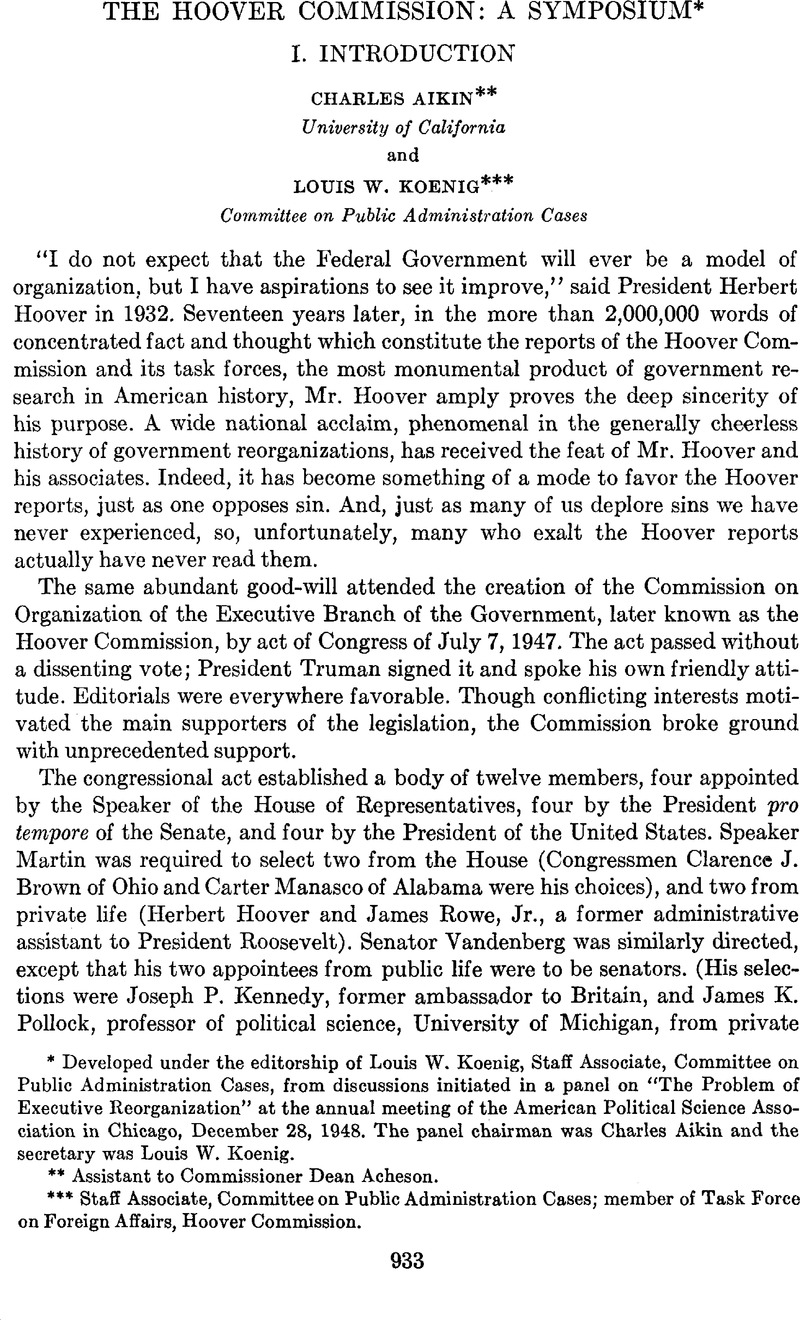Published online by Cambridge University Press: 02 September 2013

1 The Works of Alexander Hamilton, ed. Lodge, Henry Cabot, Vol. I, p. 219Google Scholar.
2 Cushman, Robert E., “The Problem of the Independent Regulatory Commissions”, in President's Committee on Administrative Management, Report with Special Studies (Washington, 1937), pp. 203–243Google Scholar. ProfessorCushman, subsequently expanded this report into a sizable volume, The Independent Regulatory Commissions (New York, 1941)Google Scholar; but the approach was primarily that of legislative history, statutory arrangements, and judicial interpretations rather than an examination of administrative experience with the commissions.
3 Take, as an illustration of the approach, the following sentence in the Cushman report, relating to the matter of commission interference with the President's responsibility for broad policy formulation: “The actual extent to which the President has been bothered in this regard is perhaps of less interest here than are the potentialities of interference.” Op. cit., p. 220.
4 The task force on Regulatory Agencies was the sixteenth set up by the Commission, its membership consisting of Owen D. Young, ex-Senator Robert M. La Pollette, and Robert R. Bowie, of the Harvard Law School. Mr. Bowie was project director, and the executive officer was Harold Leventhal. Mr. La Follette subsequently resigned from the task force, and did not participate in the final report.
5 The survey officers and the commissions they studied were: George L. Bach, Federal Reserve Board; James M. Burns, Maritime Commission; Carl F. Farbach, Securities and Exchange Commission; Walter Galenson, National Labor Relations Board; William W. Golub, Federal Communications Commission; C. Herman Pritchett, Federal Power Commission; Edward C. Sweeney, Civil Aëronautics Board; Irene Till, Federal Trade Commission; and Ernest W. Williams, Interstate Commerce Commission.
6 Commission on Organization, Appendix N, Regulatory Commissions (Washington, 1949)Google Scholar. The surveys of the individual commissions were not published.
7 These three commissions are the Securities and Exchange Commission, the Federal Communications Commission, and the Federal Power Commission, all set up between the date of Myers v. United States, 272 U. S. 52 (1926), which seemed to hold such limitations on the removal power unconstitutional, and Humphrey's Executor v. United States, 295 U.S. 602 (1935), which upheld their constitutionality.
8 Op. cit., pp. 27–28.
9 Commission on Organization, The Independent Regulatory Commissions (Washington, 1949)Google Scholar.
10 New York Times, Jan. 26, 1949, p. 2Google Scholar.
11 Reorganization plans affecting any of seven specific agencies were required to be submitted separately, so as to facilitate their consideration and possible veto by Congress. The three commissions covered were the I.C.C., S.E.C., and Federal Reserve Board.
12 Printed in Cong. Rec., June 20, 1949, pp. 8129–30Google Scholar (daily ed.).
13 The two agencies are the N.L.R.B. and the Federal Reserve Board.
14 S. 2059, S. 2073, H.R. 5173, 81st Cong. No action had been taken on the bills by Aug. 1.
15 New York Times, Mar. 13, 1949, sec. 3.
16 See Cushman, , The Independent Regulatory Commissions, pp. 450–451Google Scholar.
17 See his letter on S. 2073, Cong. Rec., July 26, 1949, pp. 10379–80Google Scholar (daily ed.).
Comments
No Comments have been published for this article.